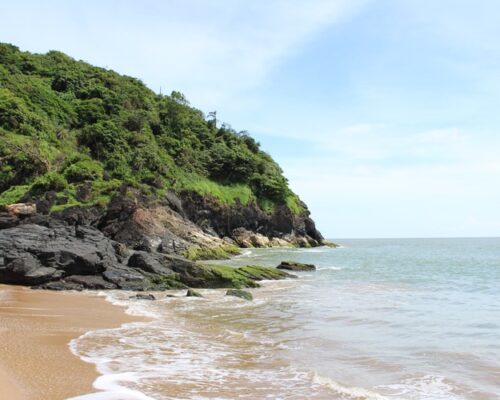The Konkan Coast runs from the Diu Daman in the north, traversing Maharashtra and Goa’s entirety before it meets and merges into the Canara coast of Karnataka and Malabar of Kerala. Whatever the demarcating names we give these natural geographic features, the cultural fluidity is more nuanced with a clear division conspicuously absent as cultures, customs and traditions gradually transform from one location to the other.
One such cultural artifact, we will explore here with a story of courage and grit or two. The West Coast of India is a curious place. It has a unique cultural heritage divergent from the rest of India. The salient features are to be found along the coastline’s entire length, all 1400 km of it. Starting from the upper reaches of Kutch, Diu-Daman, through the Konkan coast – Kolis of Maharashtra and Saraswats of Goa, Tulus of Karnataka and the Malabar region of Kerala, to the very tip of Indian mainland culminating close to Kanyakumari. The language varies as we progress southwards and much of the culture, but one underlying entity binds them together. The fact that all these societies are Matriarchal in makeup called the Aliyasanthana colloquially.

Aliyasanthana is not to be mistaken as generally is that the women are the heads of the household. This pertains to the legacy or succession rather than establishing the supremacy of women over the fiefdoms. Unfortunately, women still played second fiddle in the structure. In the Aliyasanthana form of succession, the daughter’s husband is the rightful heir to the property. Hence the name Aliyasanthana, Aliya meaning son-in-law, and Santhana meaning children in Tulu and other related languages. There is a curious story of how this came to be.
It is believed that around 77 AD, “Aliya-santāna Law” was introduced by a despotic prince called Bhūtāla-Pāndya. The legend behind this is quite fascinating.
When Deva Pandya, the uncle of Bhutala Pandya wanted to launch his newly constructed ships with valuable cargo, Kundodara – the king of demons demanded a human sacrifice for safe passage. Deva Pandya sought his wife’s permission to sacrifice their son, but his wife refused, in lieu, forcing him to offer his nephew Jaya. Kundodara recognizing future greatness in Jaya, let the ships pass without a sacrifice. Not just that, Kundodara even reinstated Jaya Pandya to his rightful place as the ruler of the Jayantika kingdom. Later, when the ships returned with immense treasures, Kundodara again sought a human sacrifice. Deva Pandya on approaching his wife for sacrificing their son yet again, along with her children, renounced the title and her claim to all the wealth. Kundodara forced Deva Pandya to nominate Jaya Pandy as the heir giving him the title Bhutala Pandya. This is how the Aliyasanthana practice came into being. Of course, there are always more rational and scientific causes for this. But we shall not explore them here.
Why all this story, you wonder? One of the major forts near Red Earth Gokarna, our resort near Gokarna is close to the little known Mirjan fort whose history could be understood only through this perspective.
Mirjan Fort was a strategic citadel as evinced by the number of hands it changed through its 800-year-old history. First built by the Nawayath Sultanate in 1200 AD, Ibn Battuta documented Mirjan Fort as a sprawling structure at Tadri Creek’s mouth with a vantage point overlooking the docking stations thus controlling the incoming and outgoing ships.

Image Credits: Wikipedia
Later the Vijayanagar Empire annexed the fort and was run as a fiefdom by the Queen Chennabhairadevi of the Tuluva Saluva clan. Follower of Aliyasanthana’s way of succession, she ruled over the North and South Canara region including south Goa, which had important ports such as Malpe, Bidnoor, Mirjan, Honnavar, Ankola, and Karwar amongst others. This controlled the pepper trade of the entire region and so Queen Chennabhairadevi was given the title pepper queen by the Portuguese, whom she kept in check. But after the downfall of the Vijayanagar Empire in the Talikota war, she retired from Mirjan to a safe place in the middle of the Sharavathi river post which various rulers successively occupied Mirjan up to the British in the 18th century.
The fort stands at the mouth of river Agnanashini spread across an area of 10 acres. The Fort was built out of locally available laterite rock and has weathered the harsh climatic conditions of summers and unforgiving monsoons for centuries and stands strong even to this day. With four entrances and as many freshwater wells, Mirjan was a city in itself. Capable of withstanding long sieges and located at the vantage of controlling the harbors, Mirjan Fort was strategic for anyone hoping to rule the region.

Image Credits: Wikipedia
A short driving distance from Red Earth Gokarna, Mirjan Fort is a piece of history, little known yet wonderful with so many stories and legends to enrich you. It is endowed with beautiful vistas of the coastline and the sea too, a perfect place to meditate or practice the Yoga lessons that you learned at Red Earth Gokarna, a wellness and Yoga resort near Gokarna.



